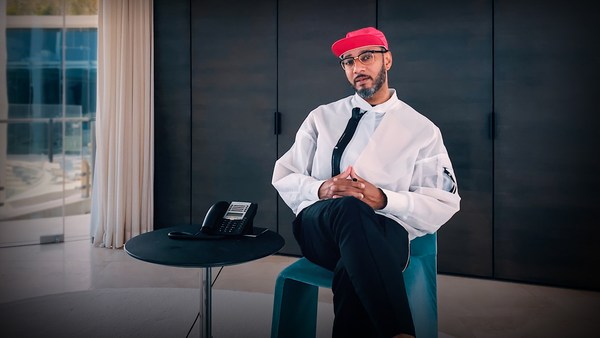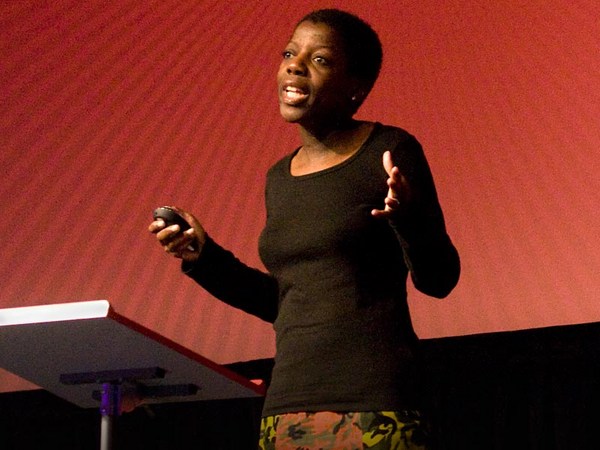I believe there is beauty in hearing the voices of people who haven't been heard.
["Drawing the Blinds," 2014]
["The Jerome Project (Asphalt and Chalk) III," 2014]
[Beneath an Unforgiving Sun (From A Tropical Space)," 2020]
That's a complex idea, because the things that must be said are not always lovely. But somehow, if they're reflective of truth, I think, fundamentally, that makes them beautiful.
(Music)
There's the aesthetic beauty of the work that in some cases functions as more of a Trojan horse. It allows one to open their hearts to difficult conversations. Maybe you feel attracted to the beauty, and while compelled by the technique, the color, the form or composition, maybe the difficult conversation sneaks up.
["Billy Lee and Ona Judge Portraits in Tar," 2016]
I really taught myself how to paint by spending time at museums and looking at the people that -- the artists, rather -- that I was told were the masters.
Looking at the Rembrandts ["The Night Watch"],
Renoir ["Luncheon of the Boating Party"],
Manet ["Luncheon on the Grass"],
it becomes quite obvious that if I'm going to learn how to paint a self-portrait by studying those people, I'm going to be challenged when it comes to mixing my skin or mixing the skin of those people in my family. There's literally formulas written down historically to tell me how to paint white skin -- what colors I should use for the underpainting, what colors I should use for the impasto highlights -- that doesn't really exist for dark skin. It's not a thing.
It's not a thing because the reality is, our skin wasn't considered beautiful. The picture, the world that is represented in the history of paintings doesn't reflect me. It doesn't reflect the things that I value in that way, and that's the conflict that I struggle with so frequently, is, I love the technique of these paintings, I have learned from the technique of these paintings, and yet I know that they have no concern for me.
And so there are so many of us who are amending this history in order to simply say we were there. Because you couldn't see doesn't mean we weren't there. We have been there. We have been here. We've continued to be seen as not beautiful, but we are, and we are here. So many of the things that I make end up as maybe futile attempts to reinforce that idea.
["Drawing the Blinds," 2014]
["Seeing Through Time," 2018]
Even though I've had the Western training, my eye is still drawn to the folks who look like me. And so sometimes in my work, I have used strategies like whiting out the rest of the composition in order to focus on the character who may go unseen otherwise. I have cut out other figures from the painting, one, to either emphasize their absence, or two, to get you to focus on the other folks in the composition.
["Intravenous (From a Tropical Space)," 2020]
So "The Jerome Project," aesthetically, draws on hundreds of years of religious icon painting,
["The Jerome Project (My Loss)," 2014]
a kind of aesthetic structure that was reserved for the church, reserved for saints.
["Madonna and Child"]
["Leaf from a Greek Psalter and New Testament"]
["Christ Pantocrator"]
It's a project that is an exploration of the criminal justice system, not asking the question "Are these people innocent or guilty?", but more, "Is this the way that we should deal with our citizens?" I started a body of work, because after being separated from my father for almost 15 years, I reconnected with my father, and ... I really didn't know how to make a place for him in my life. As with most things I don't understand, I work them out in the studio. And so I just started making these portraits of mug shots, starting because I did a Google search for my father, just wondering what had happened over this 15-year period. Where had he gone? And I found his mug shot, which of course was of no surprise. But I found in that first search 97 other Black men with exactly the same first and last name, and I found their mug shots, and that -- that was a surprise. And not knowing what to do, I just started painting them.
Initially, the tar was a formula that allowed me to figure out how much of these men's life had been lost to incarceration. But I gave up that, and the tar became far more symbolic as I continued, because what I realized is the amount of time that you spend incarcerated is just the beginning of how long it's going to impact the rest of your life.
So in terms of beauty within that context, I know from my friend's family who have been incarcerated, who are currently incarcerated, folks want to be remembered. Folks want to be seen. We put people away for a long time, in some cases, for that one worst thing that they've done. So to a degree, it's a way of just saying, "I see you. We see you." And I think that, as a gesture, is beautiful.
In the painting "Behind the Myth of Benevolence," there's almost this curtain of Thomas Jefferson painted and pulled back to reveal a Black woman who's hidden. This Black woman is at once Sally Hemings, but she's also every other Black woman who was on that plantation Monticello and all the rest of them. The one thing we do know about Thomas Jefferson is that he believed in liberty, maybe more strongly than anyone who's ever written about it. And if we know that to be true, if we believe that to be true, then the only benevolent thing to do in that context would be to extend that liberty. And so in this body of work, I use two separate paintings that are forced together on top of one another to emphasize this tumultuous relationship between Black and white in these compositions. And so, that -- that contradiction, that devastating reality that's always behind the curtain, what is happening in race relations in this country -- that's what this painting is about.
The painting is called "Another Fight for Remembrance." The title speaks to repetition. The title speaks to the kind of violence against Black people by the police that has happened and continues to happen, and we are now seeing it happen again. The painting is sort of editorialized as a painting about Ferguson. It's not not about Ferguson, but it's also not not about Detroit, it's also not not about Minneapolis.
The painting was started because on a trip to New York to see some of my own art with my brother, as we spent hours walking in and out of galleries, we ended the day by being stopped by an undercover police car in the middle of the street. These two police officers with their hands on their gun told us to stop. They put us up against the wall. They accused me of stealing art out of a gallery space where I was actually exhibiting art. And as they stood there with their hands on their weapons, I asked the police officer what was different about my citizenship than that of all of the other people who were not being disturbed in that moment. He informed me that they had been following us for two hours and that they had been getting complaints about Black men, two Black men walking in and out of galleries. That painting is about the reality, that it's not a question of if this is going to happen again, it's a question of when.
This most recent body of work is called "From a Tropical Space." This series of paintings is about Black mothers. The series of paintings takes place in a supersaturated, maybe surrealist world, not that far from the one we live in. But in this world, the children of these Black women are disappearing. What this work is really about is the trauma, the things that Black women and women of color in particular in our community have to struggle through in order to set their kids out on the path of life.
What's encouraging for me is that this practice of mine has given me the opportunity to work with young people in my community. I'm quite certain the answers are not in me, but if I'm hopeful at all, it's that they may be in them.
"NXTHVN" is a project that started about five years ago. NXTHVN is a 40,000-square-foot arts incubator in the heart of the Dixwell neighborhood in New Haven, Connecticut. This is a predominantly Black and Brown neighborhood. It is a neighborhood that has the history of jazz at every corner. Our neighborhood, in many ways, has been disinvested in. Schools are struggling to really prepare our population for the futures ahead of them. I know that creativity is an essential asset. It takes creativity to be able to imagine a future that is so different than the one that is before you. And so every artist in our program has a high school studio assistant: there's a high school student that comes from the city of New Haven who works with them and learns their craft, learns their practice. And so we've seen the ways in which pointing folks at the power of creativity can change them.
Beauty is complicated, because of how we define it. I think that beauty and truth are intertwined somehow. There is something beautiful in truth-telling. That is: that as an act, truth-telling and the myriad ways it manifests -- there's beauty in that.





